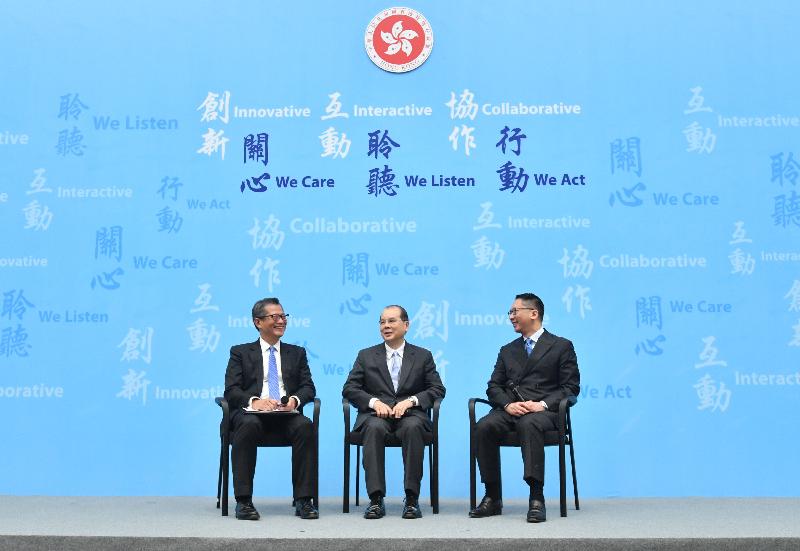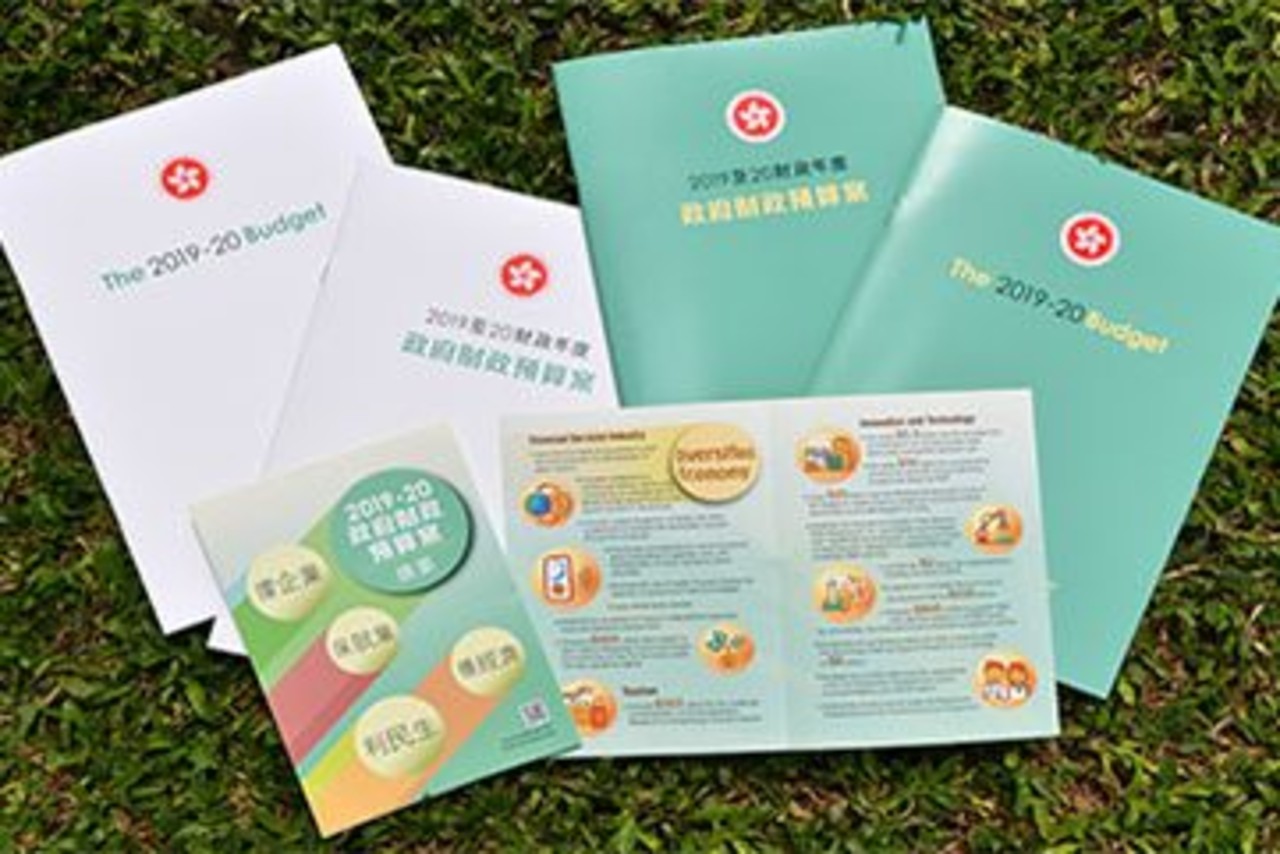February 25, 2021
Hong Kong Public Opinion Research Institute Press Conference – Press Materials
Detailed Findings
POP releases findings of Financial Budget instant survey
Special Announcement
The predecessor of Hong Kong Public Opinion Program (HKPOP) was The Public Opinion Programme at The University of Hong Kong (HKUPOP). “POP” in this release can refer to HKPOP or its predecessor HKUPOP.
Abstract
After Financial Secretary Paul Chan delivered the Budget Speech yesterday, POP conducted an instant survey on the same day and already released part of the findings last night. Apart from random landline and mobile numbers, this survey also included samples from our “Hong Kong People Representative Panel” (i.e., a panel comprising randomly recruited samples) within “HKPOP Panel”, interviewed by telephone or invited through email to complete an online survey. Our telephone survey began at around 2pm till around 7pm, while our online survey started at around 1pm till around 7pm. A total of 859 successful cases were collected, including 169 random landline samples, 177 random mobile samples, 128 panel telephone survey samples and 385 panel online survey samples. The raw data have been weighted by population statistics and proportions of different sampling frames to ensure data representativeness.
Our survey shows that, after excluding those respondents who said they did not have any knowledge of the Budget, 20% said they were satisfied with it, 56% were dissatisfied, giving a net satisfaction rate of negative 36 percentage points, while the average rating is 36.4 marks on a scale of 0 to 100. All popularity figures have significantly worsened compared to last year. The net satisfaction rate has registered an all-time low among instant surveys since records began in 1998, while the average rating has registered an all-time low among instant surveys since records began in 2008. As for Financial Secretary Paul Chan, his popularities have not changed much after he delivered the Budget Speech yesterday. His latest support rating is 36.2 marks, approval rate 27% and disapproval 51%, giving a net approval rate of negative 24 percentage points. The instant survey describes people’s instant reaction toward the Budget. Their reactions later remain to be seen.
The effective response rate of the survey excluding panel samples is 61.0%. The maximum sampling error of percentages is +/-4%, that of net values is +/-6% and that of ratings is +/-2.3 at 95% confidence level.
Contact Information
| Date of survey | : | 24/2/2021 |
| Survey method | : | (1a) Random landline telephone survey (1b) Random mobile telephone survey (2a) Telephone survey targeting “Hong Kong People Representative Panel” within “HKPOP Panel” (2b) Online survey with email invitation targeting “Hong Kong People Representative Panel” within “HKPOP Panel” |
| Target population | : | Cantonese-speaking Hong Kong residents aged 18 or above |
| Sample size[1] | : | 859 (including 169 random landline samples, 177 random mobile samples, 128 panel telephone survey samples and 385 panel online survey samples) |
| Effective response rate | : | 61.0% (excluding panel samples) |
| Sampling error[2] | : | Sampling error of percentages not more than +/-4%, that of net values not more than +/-6% and that of ratings not more than +/-2.3 at 95% conf. level |
| Weighting method | : | The raw data comes from 4 different sampling frames. It is rim-weighted by two sets of weighting factors simultaneously. The first set of weighting factors comprises population figures provided by the Census and Statistics Department, they include (a) the gender-age distribution of the Hong Kong population from “Mid-year population for 2019”, (b) educational attainment (highest level attended) distribution from “Women and Men in Hong Kong – Key Statistics (2019 Edition)”, and (c) economic activity status distribution from the last source. The second set of weighting factors is adjusted based on the relative target sample size of different sub-sampling frames, namely, random telephone survey using landline numbers set at 5 units, random telephone survey using mobile numbers set at 5 units, telephone survey of randomly pre-selected panel members set at 6 units, and online survey of randomly pre-selected panel members set at 4 units. |
Latest Figures
People’s satisfaction figures with this year’s Budget are summarized below together with the previous findings:
| Date of survey | Sample size[3] | Appraisal of Budget | |||||
| Satisfaction rate[4] | Half-half[4] | Dissatisfaction rate[4] | Net satisfaction rate | Mean value[4] | Rating of Budget | ||
| 24/2/21 | 731 | 20+/-3%[5] | 18+/-3%[5] | 56+/-4%[5] | -36+/-6%[5] | 2.2+/-0.1[5] | 36.4+/-2.3[5] |
| 26/2/20 | 991 | 46%[5] | 23% | 27%[5] | 19%[5] | 3.2[5] | 54.1[5] |
| 27/2/19 | 561 | 23% | 26% | 39% | -16% | 2.7 | 47.1 |
| 28/2/18 | 551 | 26%[5] | 28% | 41%[5] | -14%[5] | 2.7[5] | 48.2[5] |
| 22/2/17 | 502 | 33% | 30% | 18% | 15% | 3.2 | 55.7 |
| 24/2/16 | 500 | 36%[5] | 31% | 20% | 17%[5] | 3.2 | 57.2[5] |
| 25/2/15 | 529 | 45%[5] | 28% | 18%[5] | 28%[5] | 3.3[5] | 60.2[5] |
| 26/2/14 | 695 | 24%[5] | 26%[5] | 45%[5] | -20%[5] | 2.7[5] | 49.8[5] |
| 27/2/13 | 813 | 30%[5] | 37%[5] | 31%[5] | -1%[5] | 2.9[5] | 53.6[5] |
| 1/2/12 | 826 | 38%[5] | 33% | 26%[5] | 12%[5] | 3.1[5] | 57.0[5] |
| 23/2/11 | 911 | 27%[5] | 34% | 35%[5] | -8%[5] | 2.8[5] | 51.5[5] |
| 24/2/10 | 724 | 47%[5] | 35%[5] | 14%[5] | 32%[5] | 3.4[5] | 60.8[5] |
| 25/2/09 | 669 | 30%[5] | 43%[5] | 22%[5] | 8%[5] | 3.1[5] | 54.8[5] |
| 27/2/08 | 811 | 68%[5] | 21%[5] | 5%[5] | 63%[5] | 3.8[5] | 70.6 |
| 28/2/07 | 673 | 62%[5] | 25% | 9%[5] | 53%[5] | 3.6[5] | — |
| 22/2/06 | 577 | 50% | 26% | 19%[5] | 31% | 3.3 | — |
| 16/3/05 | 544 | 47%[5] | 29% | 11% | 36%[5] | 3.4 | — |
| 10/3/04 | 395 | 37%[5] | 33%[5] | 12%[5] | 25%[5] | 3.3[5] | — |
| 5/3/03 | 495 | 20%[5] | 23% | 50%[5] | -30%[5] | 2.5[5] | — |
| 6/3/02 | 539 | 47%[5] | 23% | 17% | 30%[5] | 3.3[5] | — |
| 7-8/3/01 | 263 | 57%[5] | 25%[5] | 13%[5] | 44%[5] | 3.5[5] | — |
| 8/3/00 | 643 | 70%[5] | 12%[5] | 4%[5] | 66%[5] | 3.9[5] | — |
| 3/3/99 | 598 | 46%[5] | 27%[5] | 10%[5] | 36%[5] | 3.4[5] | — |
| 18/2/98 | 638 | 55% | 20% | 7% | 47% | 3.6 | — |
After excluding those respondents who said they did not have any knowledge of the Budget, 20% said they were satisfied with it, 56% were dissatisfied, giving a net satisfaction rate of negative 36 percentage points. The mean score is 2.2, meaning close to “somewhat dissatisfied” in general, while the average rating is 36.4 marks on a scale of 0 to 100. All popularity figures have significantly worsened compared to last year. The net satisfaction rate has registered an all-time low among instant surveys since records began in 1998, while the average rating has registered an all-time low among instant surveys since records began in 2008.
Figures on various Financial Secretaries’ popularity before and after their Budget Speeches since 2001 are summarized as follows: [6]
| Popularity of Donald Tsang | Popularity of Antony Leung | Popularity of Henry Tang | Popularity of John Tsang | |||||
| Date of Budget Speech | 7/3/01 | 6/3/02 | 5/3/03 | 10/3/04 | 16/3/05 | 22/2/06 | 28/2/07 | 27/2/08 |
| Rating before the Budget | 71.9 | 57.2 | 48.1 | 57.4 | 59.7 | 63.0 | 60.8 | 56.0 |
| Rating at instant survey | 69.7 | 63.4 | 49.8 | 59.9 | 63.3 | 63.0 | 64.1 | 67.9 |
| Change in rating | -2.2[7] | +6.2[7] | +1.7[7] | +2.5[7] | +3.6[7] | — | +3.3[7] | +11.9[7] |
| Net approval rate before the Budget | — | — | — | — | 53% | 57% | 50% | 24% |
| Net approval rate at instant survey | — | — | — | — | 59% | 56% | 56% | 54% |
| Change in net approval rate | — | — | — | — | +6%[7] | -1% | +6%[7] | +30%[7] |
| Popularity of John Tsang | ||||||||
| Date of Budget Speech | 25/2/09 | 24/2/10 | 23/2/11 | 1/2/12 | 27/2/13 | 26/2/14 | 25/2/15 | 24/2/16 |
| Rating before the Budget | 56.7 | 58.3 | 55.4 | 50.6 | 57.8 | 56.7 | 58.6 | 62.3 |
| Rating at instant survey | 54.9 | 61.3 | 52.4 | 54.1 | 56.6 | 54.0 | 61.0 | 62.2 |
| Change in rating | -1.8[7] | +3.0[7] | -3.0[7] | +3.5[7] | -1.2 | -2.7[7] | +2.4[7] | -0.1 |
| Net approval rate before the Budget | 32% | 46% | 33% | 13% | 45% | 33% | 42% | 51% |
| Net approval rate at instant survey | 28% | 46% | 13% | 3% | 35% | 27% | 44% | 48% |
| Change in net approval rate | -4% | — | -20%[7] | -10%[7] | -10%[7] | -6% | +2% | -3% |
| Popularity of Paul Chan | ||||||||
| Date of Budget Speech | 22/2/17 | 28/2/18 | 27/2/19 | 26/2/20 | 24/2/21 | |||
| Rating before the Budget | 34.0 | 44.3 | 37.6 | 26.6 | 35.2+/-2.6 | |||
| Rating at instant survey | 47.4 | 44.5 | 40.5 | 43.5 | 36.2+/-2.2 | |||
| Change in rating | +13.4[7] | +0.2 | +2.9 | +16.8[7] | +1.0 | |||
| Net approval rate before the Budget | -29% | -12% | -26% | -36% | -21+/-7% | |||
| Net approval rate at instant survey | 4% | -12% | -31% | -14% | -24+/-6% | |||
| Change in net approval rate | +33%[7] | — | -4% | +22%[7] | -3% | |||
Instant survey shows that Financial Secretary Paul Chan’s popularity has not changed significantly after he delivered the Budget Speech yesterday. His latest support rating is 36.2 marks, approval rate 27% and disapproval 51%, giving a net approval rate of negative 24 percentage points.
Data Analysis
Our latest Budget instant survey shows that, after excluding those respondents who said they did not have any knowledge of the Budget, 20% said they were satisfied with it, 56% were dissatisfied, giving a net satisfaction rate of negative 36 percentage points, while the average rating is 36.4 marks on a scale of 0 to 100. All popularity figures have significantly worsened compared to last year. The net satisfaction rate has registered an all-time low among instant surveys since records began in 1998, while the average rating has registered an all-time low among instant surveys since records began in 2008.
As for Financial Secretary Paul Chan, his popularities have not changed much after he delivered the Budget Speech yesterday. His latest support rating is 36.2 marks, approval rate 27% and disapproval 51%, giving a net approval rate of negative 24 percentage points.
The instant survey describes people’s instant reaction toward the Budget. Their reactions later remain to be seen.

